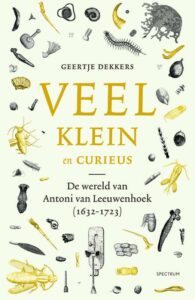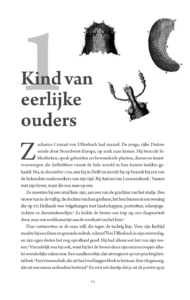Review by: Eric Jorink
In case you were not aware of it yet: 2023 is Antoni van Leeuwenhoek-year. Many activities will be devoted to commemorating the famous microscopist’s death 300 years ago. Among the events are an exhibition at Rijksmuseum Boerhaave; an international conference to be held at the Royal Society, a richly illustrated book edited by our team-members Sietske Fransen and Tim Huisman and a wonderful new biography by Geertje Dekkers, published this week.

Cover of ‘Many, small and curious’ the new Antoni van Leeuwenhoek Biography by Geertje Dekkers
Veel, klein en curieus (‘Many, small and curious’) is the main title of this very well-researched book, which is a real page-turner. Dekkers is of course not the first to describe Van Leeuwenhoek’s life. Earlier works by for example Clifford Dobell, Abraham Schierbeek and, more recently, Leslie Robertson e.a., and Dirk van Delft, come to mind. All of these books have described in great detail Van Leeuwenhoek’s citizenship of Delft, his mercantile background, his introduction to the Royal Society in 1673, and his subsequent, groundbreaking discoveries of (and communications on) bloodcells, protozoa, bacteria and spermatozoa and much more.
Scientific recognition of this ‘self-made man’ was bestowed on Van Leeuwenhoek with his election as a Fellow of the Royal Society in 1680. Between 1673 and his death half a century later, Van Leeuwenhoek would only occasionally leave his Delft; continue his microscopical researches; and write hundreds of sendbrieven, letters, most of them directed to de Royal Society. He became – and still is – a celebrity, being chosen as one of the most important Dutchmen that ever lived (in 2002).

Inside ‘Many, small and curious’
Upon his death, Van Leeuwenhoek bestowed a carefully chosen collection of his microscopes to Society – all of them now lost. Some of the very few remaining Leeuwenhoek-microscopes are in the Rijksmuseum Boerhaave (and on display at the upcoming exhibition).
So, what is new in Dekkers’ biorgraphy? Much, I would say. Most obvious is Dekkers’ point of departure. Being trained as an historian – and not like most of her predecessors as a biologist – Dekkers’ interest is not primarily in framing him as the father of microbiology, or the first observer of various kinds of bacteria or other micro-organisms. As she is very well aware – and explains to her readers – neither Van Leeuwenhoek nor his peers (including Robert Hooke, Christiaan Huygens or Nicolaes Hartsoeker) had a conceptual framework to make sense of the ‘animalcula’, ‘mites’, or ‘worms’ they observed. Moreover, Dekkers also points to the fact that present-day interests tend to obscure the fact that Van Leeuwenhoek also did important observations on plants, trees and many, many other subjects.
Instead of a earlier somewhat positivistic accounts on Van Leeuwenhoek’s life and works, Dekkers takes the reader by the hand to the world Van Leeuwenhoek lived in. His neighborhood in Delft; the frightening world of plague and child-mortality; but also Van Leeuwenhoek’s somewhat problematic understanding of the new Cartesian concept of nature, and the way this inspired and sometimes deceived his observations. It seems that Van Leeuwenhoek was basically searching for Cartesian globules through his microscopes. The author also discusses lesser known objects of Van Leeuwenhoek’s investigations, such as the skin of a black women living in Delft, or the curious experiments with divining rods in Haarlem for example.

Stamp featuring Antoni van Leewenhoek, 1937, designed by Sem Hartz
Being very well-informed, the book also poses some questions that earlier biographers have not asked. To what extend did Van Leeuwenhoek’s preconceived notions taint his interpretations? The example of Van Leeuwenhoek’s idea that the essence of a future human was encapsulated already in a spermatozo – in other words, that the female contribution to generation was confined to the role of a breeding-vessel – is well known. But Dekkers also raises some other issuess. Earlier biographers have taken at face value Van Leeuwenhoek’s own claims that he only mastered Dutch, and that he was unaware of (or ‘unclouded by’) academic learning, and could not draw.
Our team-member Sietske Fransen has demonstrated that Van Leeuwenhoek actually could draw. Maybe not as good as, for example, Huygens or Swammerdam, but well enough to send dozens of images by his own making to London between 1673 and 1680. Dekkers also questions Van Leeuwenhoek’s repeated statements that he could not understand a word of the English language – she does that not as a result of guesswork, but by specifically identifying unillustrated passages in the works of Hooke and Boyle, that proof that Van Leeuwenhoek must have read these texts. Another intriguing observation by Dekkers is that she did put Van Leeuwenhoek’s impressive computations of the smallness of creatures to the test – concluding that he made some crucial mistakes at times. Observations like these are worth keeping in mind while studying Van Leeuwenhoek’s letters, images and instruments –as we have done and will continue to do in our project.
As implied, in my view this book is by far the best biography of Van Leeuwenhoek to date. It is thoroughly documented, very well written (at times very funny), and striking the right balance between academic discourse and the common-sense approach so cherished by Van Leeuwenhoek. And I love the curious design of the book with all those small creatures and objects in the margin. A must-read for anyone interested in Van Leeuwenhoek and, more generally, the cultural world of the Dutch seventeenth century. Like major biographies on his fellow-townsman Vermeer, an English translation seems most appropriate.
